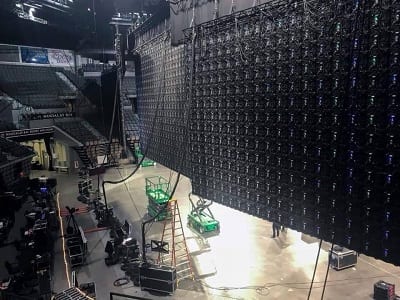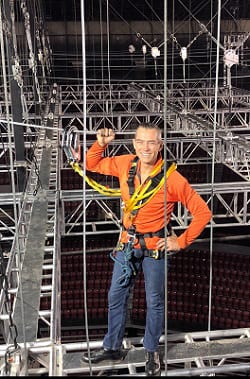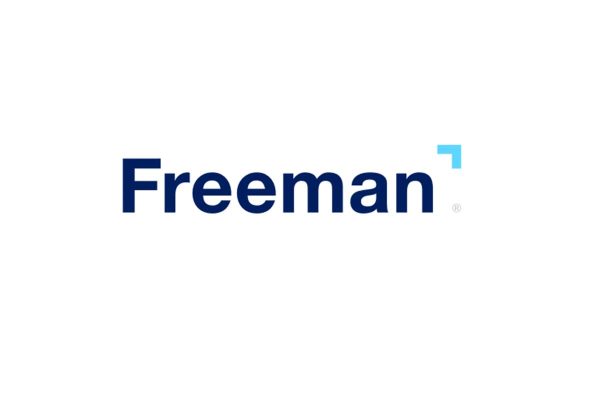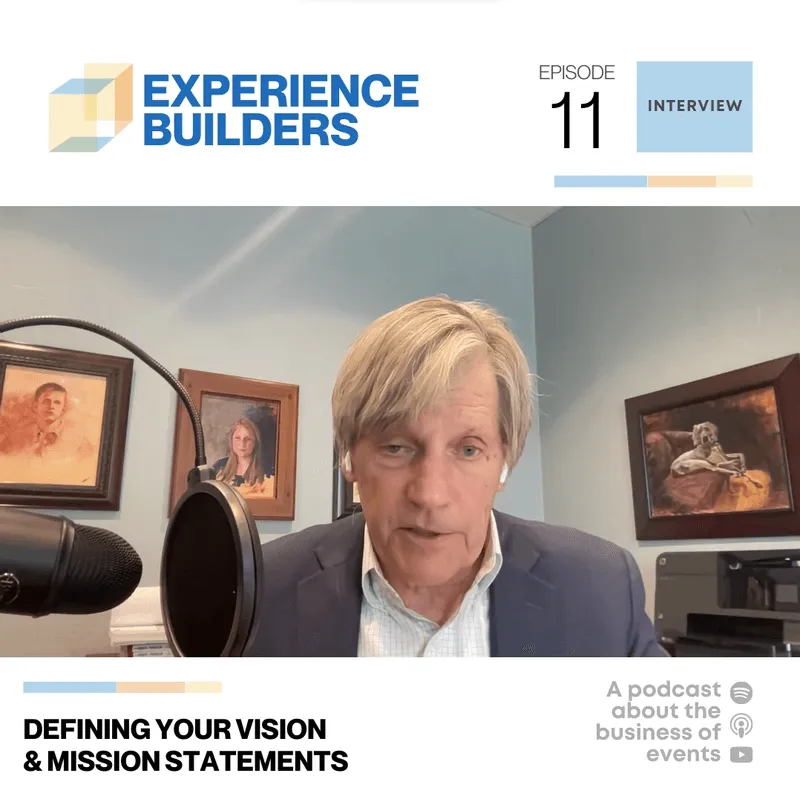by Andrew Fulton
 In May of 2019, a suspended 6,000+ lb. LED wall fell to the concrete floor in a prominent venue in Las Vegas. Luckily, no lives were lost, and no one was injured.
In May of 2019, a suspended 6,000+ lb. LED wall fell to the concrete floor in a prominent venue in Las Vegas. Luckily, no lives were lost, and no one was injured.
Why did the LED wall fall? The overall likely cause was lack of knowledge and inattention to detail, specifically, to how wire rope (which suspended the LED wall) would behave when a certain type of adjustable device was overloaded. Unbeknownst to the rigging crew, the wire rope adjustable devices were severely overloaded and applying unacceptable amounts of pressure on the wire rope. Eventually, one of the overloaded adjustable devices severed one of rigging points supporting the LED wall. one failure led to another, and the LED wall came crashing down. Luck was definitely on the side of this production rigging company for the obvious reason—no lives were lost, and there were no injuries.
 This accident presents a powerful case for why rigging training and requiring ETCP supervisors to be ETCP Certified Technicians are crucial to our industry. Knowledge is power and, correctly applied, knowledge is protective. Certification and thorough entertainment rigging training have much in common, but perhaps most importantly—they both create a safer work environment, which should be the goal of every venue/project manager out there. Those who commit to safety by seeking out quality training and then, when ready, pursuing certification successfully, should expect to see the following happen to their career:
This accident presents a powerful case for why rigging training and requiring ETCP supervisors to be ETCP Certified Technicians are crucial to our industry. Knowledge is power and, correctly applied, knowledge is protective. Certification and thorough entertainment rigging training have much in common, but perhaps most importantly—they both create a safer work environment, which should be the goal of every venue/project manager out there. Those who commit to safety by seeking out quality training and then, when ready, pursuing certification successfully, should expect to see the following happen to their career:
- More consistent employment
- Competitive advantage gained over candidates applying for the same job
- Potential to earn higher wages
- Career advancement opportunities which, in turn, could lead to promotions (i.e., becoming a production rigger, supervisor, or manager)
Choosing to pursue professional certification shows employers, clients and peers that you are committed to your profession and went the extra mile to show it. It gives them confidence in your abilities, knowing your skills have been evaluated by a well-regarded professional organization who took the time to create examinations that strictly adhere to certification standards. Professional certification enhances innate initiative and talent, shows that you are at the top of your game and that you have earned the opportunity to go even further. you know what else? It is important to say that the ETCP Council was right-on when they built educational credits into the recertification process.
Continuing education keeps us informed; it keeps us up to date on industry changes, and new operating standards and procedures. Taking courses to up our game keeps us sharp, which keeps us in tune with our rigging environments and technology. I don’t know about you, but I get busy and think, “oh, I will take that course later.” Having to have those 10 points worth of education gives me a reason, but, more importantly, I have a deadline. I must get those 10 credits before my five-year renewal period is up. Sometimes we all need that little push to learn something new, right?
Greater awareness of accidents, goals of certification and people seeking renewal credits have generated an increased interest in training, which is nothing short of terrific for our industry. The demand for training has increased (both from employers and those seeking education credits). Education helps things run more smoothly, helps people stay safe and everybody wins! The longer these certifications are attained, the more the “basic everyday rigging training” just won’t cut it anymore. ETCP Certified Technicians are the cream of the crop and they want opportunities to build upon advanced skills and tackle subjects they often do not have the chance to, but would like the opportunity to learn and practice.
 As riggers, we see challenges most days at work, but remember that some are more advanced than others, and, if you are in over your head, STOP what you are doing and take the time to find someone who has the answer. for example, when lighting trusses or projection screens must be placed over the “lower bowl” seating, outside the perimeter of an arena floor, a technique which can be employed is something commonly referred to as a “motor bridle,” pairing up multiple chain hoists to “lift and drift” these lighting trusses or screens into place. This advanced rigging technique requires solid pre-planning and a thorough understanding of the reaction forces being created. The rigging designer needs to understand every part of this process and have a well thought out rigging plan (in writing) that the project leader thoroughly understands and can communicate effectively to the team. Load drifting is an advanced rigging skill that needs to be taught and practiced, so riggers have a playbook for when these needs arise.
As riggers, we see challenges most days at work, but remember that some are more advanced than others, and, if you are in over your head, STOP what you are doing and take the time to find someone who has the answer. for example, when lighting trusses or projection screens must be placed over the “lower bowl” seating, outside the perimeter of an arena floor, a technique which can be employed is something commonly referred to as a “motor bridle,” pairing up multiple chain hoists to “lift and drift” these lighting trusses or screens into place. This advanced rigging technique requires solid pre-planning and a thorough understanding of the reaction forces being created. The rigging designer needs to understand every part of this process and have a well thought out rigging plan (in writing) that the project leader thoroughly understands and can communicate effectively to the team. Load drifting is an advanced rigging skill that needs to be taught and practiced, so riggers have a playbook for when these needs arise.
Let’s imagine this scenario: you have rigged a booth at a tradeshow where all the combined theatrical elements are already up, in place, and at trim. Then you get word that one of those elements (such as the LED wall) needs to move; your layout was correct, you rigged the LED wall where it was originally intended, but someone with bigger pockets than you decided they wanted it somewhere else. Thankfully the rigging department is not to blame, but it still has to move.
Now you have a dilemma because there is a booth structure underneath, and I can tell you from many years of experience that there are a couple of things that won’t happen:
- The exhibit company definitely does not want to go backward and take meeting rooms down. They took a lot of time to put up and that is manpower and money.
- The LED wall crew certainly does not want to bring that very expensive wall down and take it apart. again, time and money.
You could, though, as the rigging leader for the project, save the day (and time and money) because you are smart enough to have a couple of tricks up your sleeve. You know that you can access the top of the LED wall where the chain hoists attach to the bumper and that the support beams holding the LED wall are also accessible with your boom lifts. You know exactly what to do.
Maybe just last year, you did some continuing education for your ETCP renewal credits and learned the techniques and skills of “load drifting.” Because you now understand the critical nuances associated with such a technical rigging maneuver, you can offer up the solution of “drifting” the LED wall in the air to the new position over the top of the booth, which, ultimately, helps everybody. Sometimes it takes thinking outside of the box to come up with a time-saving solution. None of the booth structure had to be dismantled, nor did the LED wall need to be lowered and taken apart.
After you have saved the day, you must put away your cape and put on your hardhat. You have responsibilities to develop a safety protocol for the rest of the production team because safety is the biggest concern, no matter what. So, you establish a boundary underneath the LED wall, mark it off and make it very clear to all associated parties that no one can come within “X” amount of feet while this work is taking place. If work stops, safety comes first.
At the end of the day, you and your rigging team congratulate one another for a great rigging plan, making it happen, and everyone is relieved to have a trained, certified and/or professionally mannered rigger leading the project. You know what else? There is a good chance that your ability to problem-solve and create a safe, well-planned economical rigging solution just scored you a very happy client.
Once properly trained and then taking the steps to become ETCP certified, you no longer need luck to have a safe, timely executed, cost-controlled rigging experience. Your clients can trust that you will deliver what you’ve promised (all hinged on the safety-time-money triangle), insurance companies (the underwriters) can look forward to working with you, and your boss(es) can count on your excellent performance bringing in future business.
So, back to the LED wall rigging failure. Does having the training and certification prevent all accidents? No, but certified riggers provide experience, fine-tuned skills and enhanced technical training on the job. In hindsight, if there had been a clear understanding of the characteristics of the equipment and materials used to hang that LED wall, and an awareness of how these pieces and parts could detrimentally affect each other, there is a strong likelihood that this accident would not have happened.
Trends are showing that more and more clients and venues want to work with certified riggers who understand and maintain high rigging standards. If you are just beginning in the industry, make sure you take the time to invest in training to be sure you know exactly what you are doing. Most important? Do some research on the trainers and courses you’re considering. Are they an ETCP Recognized Trainer or Training Provider, or do they have a reputation in the industry for providing quality training? You might just be starting your rigging career, but seeking this type of education can prepare you to take the exam. Make sure you are seeking out valuable information.
 I became ETCP Certified in Arena Rigging in 2013, often work as a Rigging Accidents Investigator and have a Master Rigger Certification for heavy industrial rigging. Believe me, I have seen days where luck did not prevail. What we do is dangerous business and comparing those “near-misses” to those “not-so-near misses” is frightening. My colleague, Jason Sellmann and I have had many conversations about what mishaps could have been avoided if properly trained technicians have been on the job. We feel so strongly about encouraging training, that we have developed an entertainment rigging school in Las Vegas. ETCP Certified Technicians have told us that they are looking for new and more challenging courses; we are rising to that challenge by developing advanced topics that will now count for full renewal credits as Rig for Success was just approved to become an ETCP Recognized Training Program.
I became ETCP Certified in Arena Rigging in 2013, often work as a Rigging Accidents Investigator and have a Master Rigger Certification for heavy industrial rigging. Believe me, I have seen days where luck did not prevail. What we do is dangerous business and comparing those “near-misses” to those “not-so-near misses” is frightening. My colleague, Jason Sellmann and I have had many conversations about what mishaps could have been avoided if properly trained technicians have been on the job. We feel so strongly about encouraging training, that we have developed an entertainment rigging school in Las Vegas. ETCP Certified Technicians have told us that they are looking for new and more challenging courses; we are rising to that challenge by developing advanced topics that will now count for full renewal credits as Rig for Success was just approved to become an ETCP Recognized Training Program.
Does having training and using only ETCP Certified Technicians in supervisory positions prevent all accidents? No, of course not. But what it does do is bring heightened awareness and educated professionalism to the job. Trends are showing more and more clients and venues want to work with certified riggers who understand and maintain high rigging standards. They want technicians who are in step with these trends. Make sure you are on the right track.
This article first appeared in the Summer 2019 issue of Protocol, the journal of ESTA. www.esta.org” and was followed by appearing in the November/December issue of Exhibit City News, p. 50. For original layout, visit https://issuu.com/exhibitcitynews/docs/ecntears_novdec_2019_copy
Andrew Fulton is a longstanding member of IATSE Local 720 and is the lead production rigger at UNLV’s Thomas & Mack Center. He was the lead rigger for PRG at the Sands Expo, Venetian and Palazzo hotels from 2012-15. Along with Jason Sellmann, he co-founded RIG FOR SUCCESS with the intention of teaching project management & leadership pertaining to entertainment rigging industry. He is also one of three owners of RIGGING INTERNATIONAL GROUP (R.I.G.) a Las Vegas-based rope access training & services company that will be instructing the Entertainment Rigging School curriculum. Contact him at andrew@rigforsuccess.com






























